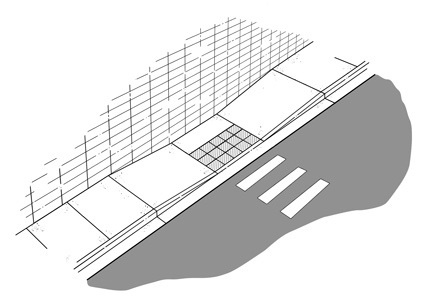3. New Construction vs. Alterations
The requirements in the ADA Standards for curb ramps newly constructed post-ADA (construction commenced after January 26, 1992) can be found in § 4.7. The requirements for curb ramps that have been altered post-ADA are the same, except for in the following cases.
When pre-ADA streets or sidewalks are altered, there may be space limitations that restrict how much they can be altered to install accessible curb ramps. In these cases, the curb ramps installed must meet the accessibility requirements of the ADA to the maximum extent feasible.10 Scoping requirements in the ADA Standards establish limitations for the running slope of the ramp run of curb ramps installed during alterations to pre-ADA streets and walkways.11
The Civil Rights Division recognizes that there will be very rare instances when it will be technically infeasible for a curb ramp installed during alterations to pre-ADA roadways and walkways to be constructed in full and strict compliance with the requirements of ADA Standards § 4.1.6(3)(a) and § 4.7 because of physical or site constraints. In such circumstances, state and local governments must install curb ramps that provide accessibility to the maximum extent feasible.12 Before reaching a conclusion about technical infeasibility, state and local governments need to consider the extent to which physical or site constraints can be addressed by alternative curb ramp designs. The burden of proving technical infeasibility lies with the state or local government that constructed it.
Alternative Curb Ramp Designs
A parallel curb ramp consists of two ramps joined in the middle by a landing that is level with the roadway. Parallel curb ramps run parallel to the curb and usually take up the whole width of the sidewalk. Combined curb ramps are a combination of the perpendicular and parallel curb ramp designs. The combined curb ramp breaks the elevation change between the curb and the street into two parts, and uses a separate ramp to bridge each part: a parallel ramp from the sidewalk to a level landing, and a perpendicular ramp from the level landing to the roadway.
10 28 C.F.R. § 35.151(b).
11 ADA Standards § 4.1.6(3)(a).
12 ADA Standards § 4.1.6(1)(j).
When highways, streets, and roads are built or altered post-ADA, they must have curb ramps at certain locations. Curb ramps must be located wherever there are curbs or other barriers to entry from a pedestrian walkway or sidewalk, including any intersection where it is legal for a pedestrian to cross the street, whether or not there is any designated crosswalk. Curb ramps must also be located wherever there are curbs or other barriers to entry at any designated pedestrian crosswalks that are located mid-block. Likewise, when sidewalks or walkways are built or altered post-ADA, they must include curb ramps or other sloped areas wherever they intersect with highways, streets, or roads and pedestrians may legally cross the vehicular way as well as at public transportation stops.
By contrast, for pre-ADA highways, streets, roads, and sidewalks that have not been altered, state and local governments may choose to construct curb ramps at every point where a pedestrian walkway intersects a curb. However, they are not necessarily required to do so. Under a more flexible standard called “program access,” alternative routes to buildings may be acceptable where people with disabilities must travel only a marginally longer route than the general public.


User Comments/Questions
Add Comment/Question